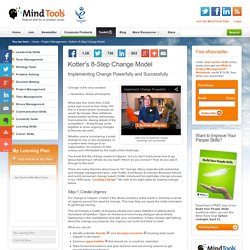

Change Management. Managing Change Guide. If you would like to download a word version of the managing change guide click here: Part 1 - Managing Change (word) Part 2 - Worst Practice Guide (in Energy & Environmental Management) (word) Part 3 - Influencing Senior Management - Getting It Wrong (word) Written by Phil Harding (philharding.net) and John Pooley (The John Pooley Consultancy) this guide was first produced by the Government Office for the South West (Sustainability & Environmental Technologies Team) in partnership with Envirowise (now part of WRAP) in 2004 and re-published as a paperback in 2007 for its 4th print run.

It is also endorsed by the Carbon Trust, ESTA (the Energy Services and Technology Association), and Climate SouthWest. © Government Office for the South West, 2004 - 2007. Special workshops or conference presentations from the authors Phil Harding - on change management including staff engagement, leadership, and motivation (UK) John Pooley - on employee and corporate engagement (UK and overseas) With jazz!
Change Management Learning Center - Prosci. 10 Principles of Change Management. Updated: 10 Principles of Leading Change Management This classic guide to organizational change management best practices has been updated for the current business environment.

To read the newest article, click here. Or, to watch a related video, click on the play button above. Way back when (pick your date), senior executives in large companies had a simple goal for themselves and their organizations: stability. Shareholders wanted little more than predictable earnings growth. Market transparency, labor mobility, global capital flows, and instantaneous communications have blown that comfortable scenario to smithereens.
This presents most senior executives with an unfamiliar challenge. Long-term structural transformation has four characteristics: scale (the change affects all or most of the organization), magnitude (it involves significant alterations of the status quo), duration (it lasts for months, if not years), and strategic importance. 1. 2. 3. 4. 5. 6. 7. Managing Change. Kotter's 8-Step Change Model - Change Management Training from MindTools. Implementing Change Powerfully and Successfully Learn how to implement change powerfully and successfully Change is the only constant. – Heraclitus, Greek philosopher What was true more than 2,000 years ago is just as true today.

We live in a world where "business as usual" is change. New initiatives, project-based working, technology improvements, staying ahead of the competition – these things come together to drive ongoing changes to the way we work. Whether you're considering a small change to one or two processes, or a system wide change to an organization, it's common to feel uneasy and intimidated by the scale of the challenge. You know that the change needs to happen, but you don't really know how to go about delivering it. There are many theories about how to "do" change. Step 1: Create Urgency For change to happen, it helps if the whole company really wants it.
This isn't simply a matter of showing people poor sales statistics or talking about increased competition. Note: Key Points. John Kotter's Leading Bold Change (Our Iceberg Is Melting) Change Management. Organisational Change Management. Change. Change Management.